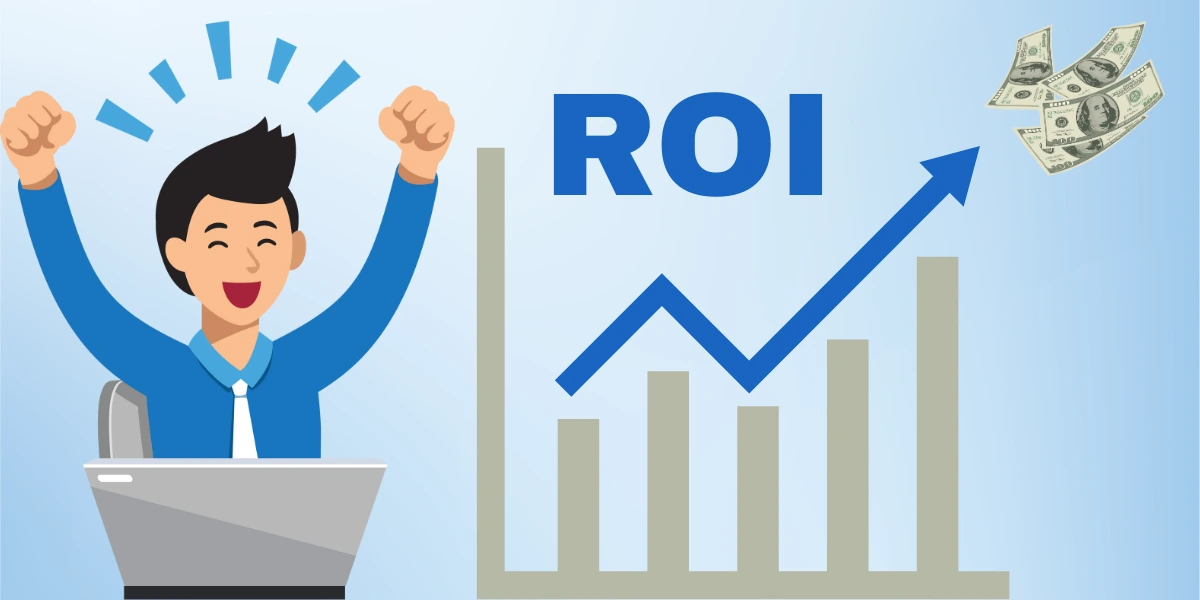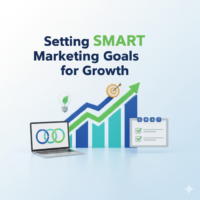How to Improve Your Content Marketing ROI Strategy
Published: 22 Sep 2025
Measuring your content marketing ROI strategy is more important than ever. Creating great content is just the start; you must know if it’s working. Content Marketing ROI helps you see the value your content brings, from generating leads to boosting sales.

By improving ROI, you can make smarter choices, save time and resources, and get better results. Whether a small business or a big brand, understanding how to improve your content marketing ROI is essential for long-term success.
In this article, we’ll show you how to track and boost your ROI to get the most out of your content.
What is Content Marketing ROI and Why It Matters
ROI in content marketing means return on investment, which measures how much profit or value you get from the money, time, and resources you spend creating and promoting content. In simple words, it’s about checking if your content efforts are bringing in more leads, sales, or brand growth compared to what you spent.
Understanding your ROI is key to tracking your success. It helps you know what’s working and what’s not. Without measuring ROI, you may waste resources on content that doesn’t bring results.
Why Content Is an Essential Part of Your Marketing Strategy
Content is more than just text or images. It’s a powerful tool for building brand awareness, engaging customers, and driving growth. Here’s how:
- Reach: Quality content helps your brand reach more people. It spreads across platforms and attracts a broader audience.
- Traffic: Engaging content brings more visitors to your website. This can lead to more potential customers.
- Engagement: When people interact with your content, it builds trust. Engagement shows they value what you offer.
- Thought Leadership: Sharing valuable insights positions your brand as an expert. This builds credibility.
- Leads: Great content encourages visitors to sign up, download, or take action, turning them into potential customers.
- Revenue: Ultimately, content marketing drives sales. It helps convert leads into paying customers, boosting your revenue.
By focusing on these key areas, you can measure and improve the ROI of your content marketing efforts.
How to Measure Content Marketing ROI
Measuring Content Marketing ROI is the key to understanding how well your content works. It helps you see if your efforts are paying off or if you need to adjust your strategy. Here’s how to do it:
Understand Your KPIs
Key Performance Indicators (KPIs) are the numbers that tell you how well your content is doing. These include website traffic, lead generation, or social media engagement. By setting clear KPIs, you can track your progress and measure success.
KPI Example Table
| KPI | What It Measures | Example Goal |
|---|---|---|
| Website Traffic | Number of visitors to your site | 1,000 visits per blog post |
| Email Subscribers | People signing up for emails | 100 new subscribers/month |
| Social Media Engagement | Likes, shares, and comments | 500 likes and shares/week |
| Leads Generated | New people interested in your offer | New people are interested in your offer |
Calculate Content Production Costs
To understand your ROI, you need to know how much it costs to create your content. This includes writer fees, graphic design, video production, or any other resources you use. Knowing this helps you compare the costs to the results you get.
Account for Distribution Costs
Creating content is just one part. Promoting it is the other. Add up your spending on ads, social media promotions, or email marketing. This helps you understand the cost of getting your content in front of your audience.
Analyze Monetary Return on Investment
What are you getting back in return? Look at how your content has driven sales, sign-ups, or other revenue-generating actions. This is the direct money made from your content, and it’s the heart of ROI.
Consider Brand Value
Sometimes, the value of content isn’t just about money. Content can build brand awareness, trust, and credibility. These benefits might not always have an immediate monetary value, but they help grow your brand over time.
By following these steps, you can measure the full impact of your content marketing efforts and make smarter decisions for future campaigns.
Top Strategies to Improve Your Content Marketing ROI

Improving your Content Marketing ROI is all about working smarter, not harder. Using the right strategies can boost your results without spending more. Here are some practical ways to get more out of your content:
1. Reduce Content Marketing Costs
You don’t have to break the bank to create great content. Look for ways to cut costs, like using free design tools or repurposing content. By being resourceful, you can maintain high-quality content without overspending.
2. Target the Right Audience
Focus on reaching the right people. Understand your ideal customer and create content that speaks directly to them. When you target the right audience, your content becomes more effective, leading to higher engagement and better ROI.
Best Practices
- Conduct surveys.
- Analyze Google Analytics demographics.
- Use tools like SparkToro for audience insights.
Equation:
Right Audience + Relevant Content = Better Engagement + Higher ROI
3. Increase Content Quality
Quality is more important than quantity. High-quality content that provides value will naturally attract more traffic and keep visitors engaged. The better your content, the more likely it is to convert readers into leads or customers.
60% of marketers say that long-form content generates the best results (Semrush).
But not every post performs equally.
Focus on:
- Evergreen SEO blogs (stay relevant over time)
- Case studies (boost trust and conversions)
- Product comparisons (convert mid-funnel leads)
| Content Type | Lifespan | ROI Potential |
|---|---|---|
| SEO Blog | 12-24 months | High |
| Viral Post | 1-2 weeks | Medium |
| Case Study | 12 months | High |
4. SEO Optimization for Better Results
SEO is a powerful tool to boost your content’s visibility. By optimizing your content for search engines, you can increase traffic and reach a broader audience. More traffic means more chances to convert visitors into leads.
SEO Formula for ROI:
Traffic x Conversion Rate x Customer Value = Content ROI
10,000 visits x 3% x $100 = $30,000 revenue
Action Plan:
- Target low-competition, high-value keywords.
- Build backlinks through guest posts, directories, and HARO.
- Use internal links from viral to SEO pages.
5. Repurpose Content
You don’t need to create fresh content every time. Instead, repurpose existing content into different formats, such as videos, infographics, or social media posts. This way, you get more value from the same content, reaching new audiences and improving ROI.
Repurposing can increase content reach by 3X (HubSpot).
How?
- Turn blogs ➜ YouTube videos ➜ Social posts ➜ Podcasts.
- Example:
➔ 1 blog ➔ 1 infographic ➔ 3 tweets ➔ 1 LinkedIn post ➔ 1 video.
Result: Same effort ➜ More exposure ➜ Better ROI.
6. Continuously Measure and Opt
What gets measured gets managed. And what gets optimized improves ROI.
Key Metrics:
- Content shares & backlinks (Ahrefs, SEMrush)
- Traffic (Google Analytics)
- Engagement (Time on page, Bounce rate)
- Leads & Conversions (CRM)
| Metric | Tool | Why Track? |
|---|---|---|
| Traffic | Google Analytics | Volume + Sources |
| Engagement | GA, Hotjar | Quality of Visits |
| Leads | HubSpot, Mailchimp | ROI impact |
| Backlinks | Ahrefs, SEMrush | SEO power |
These strategies can improve your content marketing ROI and get better results with less effort.
Overcoming Challenges in Measuring Content Marketing ROI
Measuring Content Marketing ROI isn’t always straightforward. Many businesses face common challenges when trying to track their content’s performance. Here are some of the most significant issues and how to tackle them:
1. Cost Complications
Tracking content production and distribution costs can be tricky. There are many expenses, like writer fees, graphic design, and advertising, so getting an exact figure for all costs can be challenging. To make it easier, keep detailed records and break down costs by content type or campaign.
2. Measuring Content Value
Not all content drives direct sales. Some content builds brand awareness or trust, which is harder to measure. While these intangible benefits don’t bring in immediate revenue, they still add value in the long run. You can track metrics like brand mentions or social shares to measure this value.
3. Attribution Issues
Attributing content directly to sales or conversions can be difficult. Often, a customer interacts with several pieces of content before purchasing. To solve this, tools like Google Analytics or CRM software can be used to track customer journeys and see which content contributed to the sale.
By recognizing these challenges and using the right tools, you can get a clearer picture of your content marketing ROI. This helps you make more informed decisions and improve future strategies.
Practical Methods for Calculating ROI
Measuring the financial value of your content can seem challenging, but there are simple methods to calculate ROI. Here are some practical ways to do it:
1. Conversion Analysis
Look at the number of conversions your content generates. This means tracking how many visitors take a desired action, like purchasing or filling out a form. By measuring conversions, you can see how content directly impacts sales.
2. Lifetime Traffic Value
Content can bring value over time, not just immediately. Lifetime Traffic Value tracks how much long-term traffic your content generates. It shows how your content continues to drive value even after publication.
3. Signup Attribution
Track these actions as part of your ROI if your content encourages signups or lead generation. Measure how many signups or leads result from specific pieces of content. This is an essential indicator of how well your content attracts potential customers.
Using these methods, you can put a dollar value on your content and understand its impact.
Final Thoughts
Improving and tracking your Content Marketing ROI is a continuous process. It’s not something you do once and forget about. As your business grows, your ROI should evolve, too. Using the right tools and strategies, you can forecast future ROI based on past results. This helps you make smarter decisions for your content marketing strategy. Start applying the techniques we discussed today, and keep refining them. Over time, your ROI will improve, leading to more efficient and effective marketing.
Frequently Asked Questions
- How can I quickly improve my content marketing ROI?
- Optimize your content distribution channels (e.g., social media, email, SEO).
- Focus on targeting the right audience with personalized content.
- Repurpose existing content to reach a wider audience.
- Improve content quality for better engagement and conversion.
- What KPIs should I track for content marketing ROI?
- Conversion rate: How many visitors take action, like purchasing or signing up.
- Lead generation: The number of leads collected from your content.
- Engagement: Social shares, comments, and interactions with your content.
- Traffic: How much traffic does your content drive to your website?
- How do I handle content ROI forecasting?
- Create a simple content ROI model by tracking past performance.
- Use data from previous campaigns to estimate future returns.
- Adjust your model based on trends and changes in audience behavior.

- Be Respectful
- Stay Relevant
- Stay Positive
- True Feedback
- Encourage Discussion
- Avoid Spamming
- No Fake News
- Don't Copy-Paste
- No Personal Attacks

- Be Respectful
- Stay Relevant
- Stay Positive
- True Feedback
- Encourage Discussion
- Avoid Spamming
- No Fake News
- Don't Copy-Paste
- No Personal Attacks




